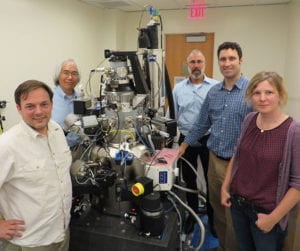
Researchers in QB3-Berkeley’s Biomolecular Nanotechnology Center (BNC) are celebrating the September 30 arrival of a Zeiss ORION NanoFab microscope, a multibeam instrument that researchers will use for unprecedented investigations of matter.
Purchased with a $2 million NSF grant, the new tool is the first of its kind at an academic institution in the U.S. The microscope integrates three kinds of ion beams – gallium, neon, and helium – enabling researchers to manipulate and image matter down to less than 10 nanometers quickly, precisely, and efficiently.
Berkeley faculty members overseeing the new instrumentation include Professors Peter Hosemann, Jeffrey Bokor, Nipam H. Patel, Andrew M. Minor, and Michael F. Crommie. Dr. Frances Allen, a Berkeley Research Project Scientist, will manage the device and work closely with users in the BNC, which is directed by Paul Lum.
The instrument opens a new window into small-scale mechanics, the limits of strength, and electronic properties. It also allows the in-situ implantation of He on a small scale, delivering insight for a number of nuclear applications including fission and fusion power.
Researchers will use the device for near damage-free surface imaging of organic materials of biological and non-biological origin, semiconductors, and other structural materials with unprecedented resolution, making it possible to address key issues in structural engineering, molecular cell biology, and the analysis of two-dimensional materials such as graphene. In addition, it allows for the manipulation (cutting, joining, coating, and moving) of any solid matter down to the sub-10 nanometer scale, enabling the creation of totally new structures for material science applications and biological experiments.
Zeiss engineers have just begun the process of installing and calibrating the device, which will take several weeks. After several months of testing by a small number of labs, the instrument will be available to a wide range of users who are affiliated with UC as well as those from other institutions in academia and industry.
Related links
Carl Zeiss ORION NanoFab